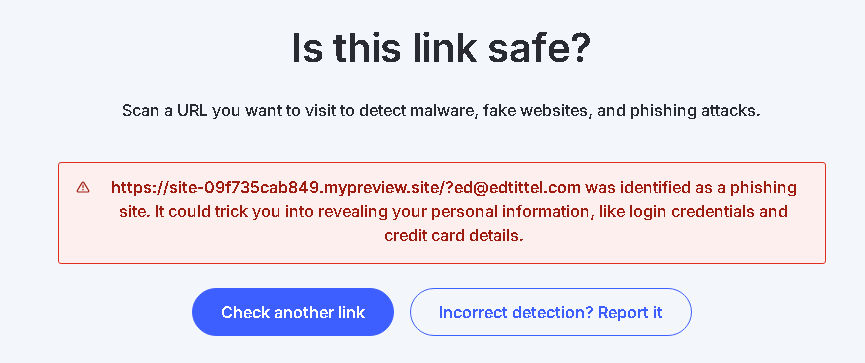I’ll admit it: I’m a cynic when it comes to emails that ask me to follow a link to verify something. If somebody asks for verification unsolicited, I believe by default that request is malign. So when an email showed up asking me to verify my account to keep my email server going, my first instinct was “Heck NO!” And, as the NordVPN link-checker immediately confirmed , my instincts are good. It pops up instantly as a phishing site. Skepticism is spot on, and e-mail link cynicism is well-considered — at least IMO.
Check to See if E-mail Link Cynicism Is Well-Considered
If in doubt, check the link at a third-party site. NEVER click a link from an unknown sender. If you’re incurably curious, do it from a sandbox or VM you can blow away if something bad happens. The important thing is to think about what’s in your inbox, how it got there, and how it might bite you.
Here’s what the NordVPN site says. It’s great advice so I’ll repeat it verbatim:
Got a suspicious email or text? Check the link before clicking — it will significantly reduce the chances of you falling for a phishing attack.
When in doubt, check. If you can’t check, don’t click: wait until you can (or delete the email). If it’s really important and legit, the sender will resend and you’ll get another opportunity to recheck what’s going on.
Reverse Lookup Mojo
Indeed, if you are concerned about a reported issue or account problem, it’s much safer for YOU to visit a known, good, working vendor site to check on status. Amazon is a good example: I can’t tell you how many bogus SMS text messages I’ve gotten on my cell that ask for Amazon account details to confirm things, because I delete them as soon as they appear. As a matter of policy Amazon does not request sensitive info (passwords, credit card data, etc.) via SMS, though they do report order and delivery status that way.
Be smart when you respond to emails. If there’s any doubt, open your own link to a trusted vendor and check things from your end. If you don’t recognize a sender asking for sensitive info, don’t respond. This is a case where doing nothing is exactly what’s right — and safest.
